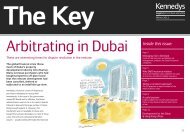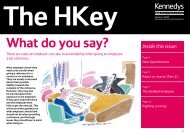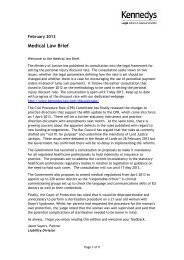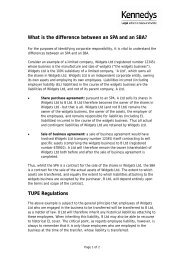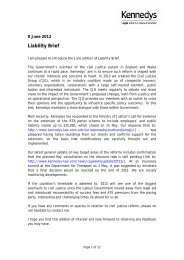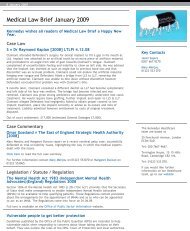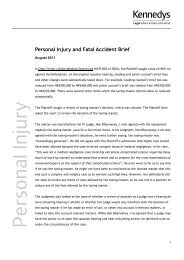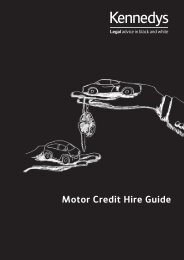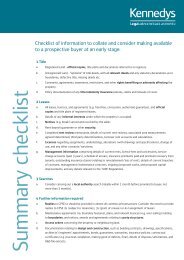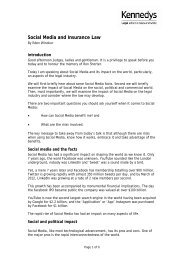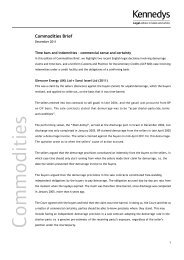Disease Brief - Kennedys
Disease Brief - Kennedys
Disease Brief - Kennedys
Create successful ePaper yourself
Turn your PDF publications into a flip-book with our unique Google optimized e-Paper software.
1 April 2011<br />
<strong>Disease</strong> <strong>Brief</strong><br />
Welcome to the latest edition of <strong>Disease</strong> <strong>Brief</strong>, the quarterly publication from<br />
<strong>Kennedys</strong>’ Occupational <strong>Disease</strong> Unit. In this edition, we include a report on the<br />
decision dismissing the Miners’ Knee Group Litigation and feature articles on a<br />
number of topical issues prepared by disease specialists from our Birmingham<br />
office including partner, Philippa Craven.<br />
Another important recent development has been the Supreme Court’s decision on<br />
mesothelioma claims in Sienkiewicz v Greif (UK) Ltd and Willmore v Knowsley<br />
Metropolitan Borough Council. The full impact of the decision remains to be seen,<br />
although it is likely that there will be an increase in claims, given that a claimant<br />
needs only to establish exposure greater than de minimis. We explore this decision<br />
further in our recent e-update. [link to http://www.kennedyslaw.com/media/emails/liability/<strong>Disease</strong>/<strong>Disease</strong>_E_Update_SupremeCourt_March2<br />
011.htm]<br />
We still await the Supreme Court’s decision later this month on noise induced<br />
hearing loss in Baker v Quantum Clothing Group and others. We will send an e-<br />
update once the judgment is available. In the meantime, you may find our<br />
summary of the Court of Appeal decision useful. [link to http://www.kennedyslaw.com/media/docs/<strong>Kennedys</strong>Liability<strong>Brief</strong>June2009_1262009.htm#s1i1]<br />
Last week we held our annual Occupational <strong>Disease</strong> Conference in London. It was<br />
well attended and feedback proved it was enjoyed by all. Key topics included<br />
stress and harassment claims, suspect diagnoses of mesothelioma conditions and<br />
limitation. The event was rounded off with an interactive disease related quiz! We<br />
will be repeating the conference later in the year for our clients further north,<br />
details to follow. If you would like a copy of the slides from our recent conference<br />
please email us.<br />
I hope you enjoy reading this edition and welcome any feedback.<br />
Kieron West, Partner<br />
Head of <strong>Kennedys</strong>’ Occupational <strong>Disease</strong> Unit<br />
Changing litigation landscape<br />
Following the Government’s announcement this week there is to be root and<br />
branch reform of civil justice. Our e-update [link to: http://kennedysvx.com/exchange-sites/30/646/march-2011/liability-e-update.asp?]<br />
focuses on the<br />
Ministry of Justice’s fresh consultation paper which suggests a new vision for civil<br />
justice. In a separate key development, the Supreme Court has ruled that expert<br />
Page 1 of 11
witness immunity should be abolished. Read more >> [[link to: http://kennedysvx.com/exchange-sites/30/646/march-2011/liability-e-update.asp?]<br />
Case law<br />
Miners’ knee<br />
Claims by all eight lead Claimants in the Miners’ Knee Group Litigation<br />
dismissed on limitation grounds – Davies and others v Secretary of State for<br />
Energy & Climate Change 10.01.11<br />
The claims were part of a group litigation action pursued against the National Coal<br />
Board (NCB) by former miners for personal injury to their knees, further to working<br />
underground. The eight Claimants all suffered from knee osteoarthritis from<br />
repeated minor trips, falls, knocks and heavy lifting.<br />
All eight claims were found to be statute barred and the issue was whether the<br />
court should exercise its discretion under s.33 Limitation Act 1980 to reinstate.<br />
Held: A distinction was found between claims for osteoarthritis of the knee and<br />
other industrial diseases such as hand-arm vibration syndrome, deafness and dust.<br />
In these cases there were repeated minor traumas to the knees which fell into<br />
three categories:<br />
<br />
<br />
<br />
Traumas which were avoidable by the NCB i.e. breach of duty.<br />
Traumas which were unavoidable by the very nature of mining work i.e.<br />
non-negligent exposure.<br />
Traumas caused by the failure of a miner to take sufficient care i.e.<br />
contributory negligence.<br />
To determine which categories the cause of a trauma fell within was a far more<br />
complex exercise than in other industrial diseases. A claimant could not simply rely<br />
upon the establishment of the condition to prove his case.<br />
The following circumstances were to be taken into account by the court when<br />
exercising its discretion under s.33:<br />
<br />
<br />
The reasons for the delay from expiry of the limitation period, and how<br />
promptly a claim was brought thereafter.<br />
The effect that delay had on the fairness of the trial: whether the cogency<br />
of the evidence had been adversely affected as a result of the delay and<br />
whether it was fair and just that a claim should proceed.<br />
Page 2 of 11
The broad merits test, namely whether it would be inappropriate for the<br />
court to allow a trial to take place if the prospects of the Claimants’<br />
success were only slight.<br />
The court accepted the Defendant’s argument that, when determining the effect<br />
of delay on the fairness of a trial, it was legitimate to take account of difficulties<br />
that pre-existed the date of knowledge of the Claimant in each case.<br />
The court found that there would be little difficulty in finding a causal relationship<br />
between the knee conditions and the work. However the difficulty was determining<br />
the effect of the unavoidable conditions on the development of osteoarthritis, and<br />
that depended on the factual evidence. That was relevant to the broad merits test<br />
and the cogency of the evidence had been adversely affected by the delay. It was a<br />
tall order to expect anyone to now recall sufficient detail to explain whether<br />
conditions were avoidable at any given time or, if they were, what had been done<br />
to remedy them. In the circumstances the court chose not to exercise its<br />
discretion.<br />
Comment: It was anticipated that miners’ knee would be the next scheme, similar<br />
to vibration white finger (VWF) and chronic obstructive airways disease (COAD),<br />
but surprisingly it fell at the first hurdle. The causation of knee osteoarthritis was<br />
distinguished from other conditions and explains why a limitation defence was<br />
unsuccessful for the Defendant in the VWF and COAD actions.<br />
It seems peculiar that the Claimants argued that pre-limitation delay was<br />
immaterial, as they could have argued that the Defendant had not been prejudiced<br />
by this. The difficulties which it faced to defend the cases were arguably no<br />
greater than if the claims had commenced within the limitation period. The closure<br />
of the collieries, the redundancy of the workforce and disposal of documentation<br />
had all occurred many years before these claims materialised.<br />
We understand the Claimants intend to appeal against this decision.<br />
For further information contact Cameron Clark [Cameron.clark@kennedyslaw.com],<br />
<strong>Kennedys</strong>, 0114 253 2033.<br />
Feature articles<br />
Challenging CRU certificates in disease claims<br />
At first glance the attribution of benefits in disease claims may seem<br />
straightforward, but this is not necessarily the case.<br />
It is not sufficient to ask whether a claimant has a disease. You should instead ask<br />
how badly affected he is as a result of the exposure to the harm. Did the claimant<br />
already have the condition and, if so, how much worse has the exposure made it?<br />
Page 3 of 11
Industrial Injuries Disablement Benefit (IIDB) is a good example of this. There is<br />
considerable guidance from the benefits rules themselves in the form of<br />
“prescribed diseases”. These derive from the Social Security (Industrial Injuries)<br />
(Prescribed <strong>Disease</strong>s) Regulations 1985, as amended by the Social Security<br />
(Industrial Injuries) (Prescribed <strong>Disease</strong>s) Amendment (No. 2) Regulations 2007.<br />
It should be remembered that IIDB is only paid to those injured at work. Someone<br />
with a purely constitutional or non-work related cause should not be receiving this<br />
benefit. In appropriate cases, be prepared to challenge whether a person should be<br />
receiving this benefit.<br />
Appendix 1 of the DWP DB1 Guide to IIDB (link to<br />
http://www.dwp.gov.uk/publications/specialist-guides/technical-guidance/db1-aguide-to-industrial-injuries/appendix/appendix-1/)<br />
sets out a list of diseases and<br />
typical jobs in which disease is known to be a significant risk factor:<br />
<br />
<br />
<br />
If the job you are considering is not on the list of typical jobs, consider very<br />
carefully how much a job has affected a person’s capability and whether<br />
there is an alternative non-negligent cause, for example in the case of<br />
vibration, hobbies such as motorcycling.<br />
If the job is included on the list, this will raise a presumption that the<br />
disease has been caused by that job, assuming the Claimant was employed<br />
in that job at or around the time of onset.<br />
Even though medically the debate still rages, the DWP does recognise carpal<br />
tunnel syndrome as arising from work-related vibration.<br />
Comment<br />
When assessing benefits in disease claims, look carefully at the actual level of<br />
disability caused by the work and at other possible causes. Do not assume the DWP<br />
has got the decision right – challenge this with appropriate evidence.<br />
Ask yourself the same questions the DWP does in respect of each case:<br />
<br />
<br />
<br />
<br />
<br />
Is the claimant suffering from the disease at all?<br />
Is the disease a prescribed disease?<br />
Did the employment cause the disease?<br />
When was the date of onset of the disease?<br />
Is the claimant disabled, i.e. does he or she have restrictions due to the<br />
disease?<br />
Page 4 of 11
Finally, it should be noted that no NHS charges are recoverable in disease claims,<br />
except where the disease is attributable to a separate injury, which would then<br />
bring the entirety of the treatment within the ambit of NHS charges recovery.<br />
For further information contact Paul Morris, <strong>Kennedys</strong>, 0121 214 8027.<br />
Employers’ Liability Tracing Office<br />
FSA publishes regulations setting out requirements to publish details of policies<br />
and claims.<br />
The Employers’ Liability Tracing Office (ELTO) has been set up to help claimants<br />
find the insurer of their former employer(s) in relation to industrial accidents or<br />
diseases. It replaces the previous Employers’ Liability Code of Practice Tracing<br />
Service.<br />
The ELTO has been set up as a voluntary organisation. Over 95% of the EL insurance<br />
market have to date joined the organisation. ELTO will build and maintain a<br />
database of all new and renewed EL policies, all old EL policies that have new<br />
claims against them and all successful traces from the existing tracing service and<br />
from ELTO. Its new website goes live from April 2011. (link to<br />
http://www.elto.org.uk/)<br />
There will also be a new Employers’ Liability Database (ELD), which will be a<br />
centrally held record of new and renewed policies. This will be maintained by<br />
ELTO. The aim of the ELTO and the ELD is to increase the speed with which<br />
interested parties can search the databases for relevant insurers or policies and<br />
thus enable claims to be progressed more efficiently.<br />
FSA regulations<br />
New FSA regulations have been introduced taking effect from April 2011, requiring<br />
insurers to publish details on EL policies and new claims against EL policies.<br />
The regulations also provide that, from April 2012, the employer’s reference<br />
number (sometimes called the PAYE number) and Companies House reference<br />
number are required to be included in the ELD. It is clear that this information will<br />
assist parties in identifying the correct insurer(s) for the correct defendant. In<br />
long, and even some short tail, disease claims insurance issues can be complicated<br />
as a result of incomplete information relating to the employer company. Company<br />
acquisitions and name changes mean that additional investigations may need to be<br />
undertaken. Information contained in Inland Revenue schedules regarding<br />
employers is not always accurate and, hence, this additional information will be of<br />
assistance to all.<br />
Extended access<br />
Page 5 of 11
Access to the ELD is to be extended to employers and relevant intermediaries for<br />
insurers. It is planned that this new search facility will be available from late April<br />
2011 and that the search results will be instantly available. Where a search fails to<br />
return a result, a query will be generated and sent out to each insurance company<br />
to check their own records for older policies and any positive result then obtained<br />
will also be loaded onto the ELD.<br />
Comment<br />
Whilst the take-up from the insurance industry has so far been impressive, it is<br />
hoped that the ELTO will attract even more members. The FSA regulations also<br />
impose obligations on insurers, which should encourage their active participation in<br />
making the ELTO and ELD a success, including imposing an additional levy for<br />
failing to upload information in an agreed timescale. Nick Starling of the ABI has<br />
said that “Insurers are determined to do all they can to ensure that people with a<br />
work-related injury or disease are able to trace their employer or its insurer to<br />
claim against. This is why the industry is committed to developing ELTO into a<br />
comprehensive service to help claimants.”<br />
APIL, however, is less impressed with the new rules and believes the ELTO and FSA<br />
regulations fail to protect the rights of claimants, predominantly because the<br />
changes do not compel the publication of all policies. Karl Tonks, incoming vicepresident<br />
of APIL has said “Many sick and dying workers who can’t trace their<br />
employers’ insurers from decades ago still won’t be able to claim the<br />
compensation they need…” APIL are calling for a fund of last resort for employers’<br />
liability claims, similar to the Motor Insurers’ Bureau.<br />
The impact and success of the ELTO will undoubtedly be an issue under scrutiny<br />
and consideration over the coming months and years.<br />
For further information contact Philippa Craven, <strong>Kennedys</strong>, 0121 214 8012.<br />
Tackling claims for HAVS/VWF and CTS<br />
Claims for hand arm vibration syndrome (HAVS), vibration white finger (VWF)<br />
and carpal tunnel syndrome (CTS) are increasing. We review recent<br />
developments and tactics for defendants.<br />
HAVS is the umbrella term used to describe injuries to blood vessels, nerves and<br />
muscles in the fingers caused by hand transmitted vibration. The principal<br />
constitutional condition is Reynaud’s phenomenon, caused by Reynaud’s disease.<br />
Other causes include arterial disease, drugs and trauma.<br />
The level of the symptoms suffered is measured against the Stockholm scale and<br />
cases are classified by staging the neurological and sensorineural symptoms.<br />
Page 6 of 11
The courts have wrestled with diagnosis and, following the Court of Appeal’s<br />
decision in Montracon Ltd v Whalley [2005], approved a three step test for the<br />
diagnosis of HAVS/ VWF as follows:<br />
<br />
<br />
<br />
A history of exposure to vibration sufficient to cause risk of development of the<br />
condition.<br />
A clinical history and description of symptoms which is consistent with this.<br />
The absence of any constitutional explanation for the symptoms complained of.<br />
This Montracon or liability test has assisted claimants. Defendants have found it<br />
difficult to defend claims in the absence of evidence to determine vibration levels,<br />
exposure time, tool maintenance and training.<br />
However, since the more recent decision of the Court of Appeal in Vance-Daniel v<br />
Corus UK Ltd [2010], the question to ask now is whether the defendant should<br />
reasonably have foreseen the risk to the claimant. The claimant must now prove<br />
foreseeability and each case should be decided on its facts.<br />
Furthermore, there have been developments in diagnosis, with the use of a new<br />
cold provocation test, explained in an article by Salem and others in the Journal of<br />
Hand Surgery in October 2009. Essentially this test, if approved and adopted by<br />
medico-legal experts, can be used to isolate claimants with no vascular symptoms,<br />
those with non vibration related vascular symptoms and leave only those genuine<br />
HAVS/VWF sufferers to pursue their claims.<br />
Thereafter it will be for the defendant’s insurers to consider whether the insured,<br />
acting as a reasonable employer, should have foreseen the risk of injury to the<br />
diagnosed claimant.<br />
CTS<br />
The carpal tunnel is a channel through which tendons pass to enable finger and<br />
wrist movements, in particular bending. The median nerve also passes through the<br />
channel, to control muscles in the hand and also to move the thumb.<br />
Symptoms of carpal tunnel syndrome (CTS) include numbness, tingling and burning<br />
in the hand and fingers, principally the thumb, index and middle fingers. Symptoms<br />
can extend to the forearm, shoulder and neck. Development occurs in people over<br />
45 years of age. Those with thyroid problems and diabetes are at increased risk of<br />
development of symptoms. Carpal tunnel release is the most effective remedy.<br />
However, CTS is rarely caused by work. It is often exacerbated by repetitive<br />
manual activity and, it has been suggested, by exposure to vibration.<br />
Page 7 of 11
Often claims for HAVS/VWF have a CTS component.<br />
Vascular surgeons are often engaged to discuss medical causation at trial.<br />
Medical research casts doubt on the evidential link between vibration exposure and<br />
the onset of CTS. Causative factors play a greater role than occupational factors.<br />
The appropriate causation test set out by the Court of Appeal in Wilsher v Essex<br />
Area Health Authority [1988] still holds good today. The claimant has to prove on<br />
the balance of probabilities that vibration has caused CTS rather than medical<br />
causation e.g. diabetes or obesity.<br />
Tactics<br />
When investigating a CTS claim or CTS element in a HAVS/VWF claim, look to the<br />
claimant’s medical records. If other potential causative factors appear, then there<br />
is the potential for a good defence based on clinical causation, especially where<br />
the claimant contends that vibration has caused the CTS complained of.<br />
Indeed, in such matters and even before litigation is commenced, it is certainly<br />
worth considering putting searching Part 35 questions to the claimant’s medical<br />
expert, which may have the desired result of quashing the claim before<br />
proceedings are issued.<br />
Summary<br />
Where HAVS/VWF is alleged, there is a legal diagnosis test following Montracon.<br />
There is also a clear dose relationship between vibration and HAVS/VWF. However,<br />
as there is no (known) dose relationship between vibration and CTS, then in the<br />
presence of other causative factors, the claimant will struggle to prove causation<br />
by applying the test in Wilsher.<br />
Early challenges to the claimant’s solicitors during the pre-action protocol period<br />
can pay dividends and save money in terms of damages and costs.<br />
For further information contact John Croucher, <strong>Kennedys</strong>, 0121 214 8013.<br />
Updated pre-action protocol for disease and illness claims<br />
Although arguments for a separate pre-action protocol for mesothelioma claims<br />
have not succeeded, the updated general disease protocol, which comes into<br />
force on 6 April 2011, introduces some positive changes.<br />
In February 2010, a working party was set up to examine litigation practice and<br />
procedures for claims relating to mesothelioma. <strong>Kennedys</strong> made submissions to the<br />
Civil Justice Council, in which we argued that there should be a separate preaction<br />
protocol (PAP) for mesothelioma claims. In our view this would facilitate the<br />
more effective and time efficient handling of these claims, by providing specific<br />
Page 8 of 11
information at an early stage, thus enabling a speedier resolution of claims for<br />
claimants.<br />
It is disappointing that, after discussion and deliberation between interested<br />
parties, there is still no separate PAP dealing with mesothelioma claims. Instead,<br />
the 55 th update to the CPR incorporates some changes, specifically introduced to<br />
assist with mesothelioma claims, into the existing PAP.<br />
Defendants’ representatives had lobbied for early disclosure of witness evidence<br />
setting out employment and exposure history to be included within the PAP, but<br />
this was met with resistance by claimants’ representatives. Initiatives to assist the<br />
early payment of compensation were also discussed, but the unwillingness to agree<br />
to witness evidence meant that these too failed to result in any meaningful<br />
change.<br />
Updated pre-action protocol<br />
The main amendments to the PAP are:<br />
<br />
<br />
<br />
<br />
<br />
<br />
A provision relating to terminal disease and short life expectancy, such as<br />
mesothelioma claims, where it is accepted that the time scale of the<br />
protocol is likely to be too long. In such instances a claimant may not be<br />
able to follow the protocol and the defendant would be expected to treat<br />
the claim with urgency, including any request for an interim payment.<br />
In addition to providing a chronology of relevant events in the letter of<br />
claim, a claimant must also provide an HMRC schedule showing employment<br />
history.<br />
Where there is more than one employer, the claimant is to identify any<br />
relevant exposure during those periods of employment, including any period<br />
of self-employment.<br />
The claimant is to provide any response received from the ABI Employers’<br />
Liability Tracing Service, both negative and positive, and, where insurance<br />
database results are received after sending the letter of claim, these results<br />
should be forwarded to the defendant as soon as is reasonably practicable.<br />
Insurers or defendants are to notify claimants in writing as soon as possible<br />
where it has not been possible to identify the full insurance history within<br />
30 days and, in any event, to state which insurers have been identified<br />
within that period and state what steps are being taken to determine this<br />
information.<br />
The claimant is required to advise of any claims or payments under the<br />
Pneumoconiosis etc. (Workers’ Compensation) Act 1979.<br />
Page 9 of 11
It is recognised that expert evidence may be needed on issues of<br />
apportionment in addition to knowledge, fault, causation, condition,<br />
prognosis and valuing aspects of the claim.<br />
In addition, the PAP includes annexes C and D which relate specifically to<br />
mesothelioma claims:<br />
<br />
<br />
Annex C provides guidance, setting out that its purpose is to give as much<br />
advance warning as possible of claims to defendants and insurers and, in the<br />
case of limited life expectancy, to give advance warning as to the need for<br />
urgency.<br />
A specimen letter appears at Annex D, which suggests the information that<br />
ought to be included in early notification letters for cases involving<br />
mesothelioma.<br />
Comment<br />
The PAP does provide defendants and insurers with earlier access to some<br />
information, which will undoubtedly assist in dealing with claims more quickly.<br />
However, it is disappointing that there was resistance to some of the amendments<br />
being championed on behalf of defendants during the discussion process.<br />
It is acknowledged and accepted that victims of mesothelioma who have been<br />
negligently exposed to asbestos should be compensated. It is, however, only<br />
equitable that defendants and their insurers are provided with the necessary<br />
information to be able to properly assess their position, consider the extent to<br />
which others may have a responsibility and attempt to trace historic insurers.<br />
For further information contact Philippa Craven, <strong>Kennedys</strong>, 0121 214 8012.<br />
Old war stories<br />
Philippa Craven and Kieron West recently acted for two of the three Defendants<br />
in a mesothelioma claim where the Third Defendant, the National Dock Labour<br />
Board (NDLB) denied liability on the grounds that it was a creature of statute<br />
with limited powers and no obligations or responsibility for any workers<br />
deployed by it to work for various port employers.<br />
The defence served on behalf of the Third Defendant raised arguments previously,<br />
and unsuccessfully, argued at first instance and at the Court of Appeal in the case<br />
of Rice and Thompson v Secretary of State for Business, Enterprise and Regulatory<br />
Reform and Stuntbrand Line Ltd [2008].<br />
Notwithstanding the judgment in Rice and Thompson, in which it was held that the<br />
NDLB did owe duties and was on notice of risk, these same arguments were<br />
advanced in our case, with the Third Defendant maintaining its stance that it<br />
Page 10 of 11
would not contribute to the claim. The Third Defendant failed to respond to the<br />
challenge to differentiate the circumstances in this claim from the Rice and<br />
Thompson decision.<br />
In an attempt to deal with the Third Defendant’s intransigence, we adopted a<br />
proactive strategy to deal with the claim and made a joint Part 36 offer on the<br />
issue of contribution. This was then accepted, with the result that the Third<br />
Defendant became the majority contributor and co-ordinator for the claim.<br />
Settlement with the Claimant was achieved fairly quickly thereafter.<br />
We always strive to achieve the best results for our clients. In this case we<br />
deployed a proactive and united approach to deal with the Third Defendant as<br />
expeditiously as possible given that, whilst the Defendants remained in dispute,<br />
the Claimant’s costs were undoubtedly increasing.<br />
For further information contact Philippa Craven or Kieron West, <strong>Kennedys</strong>.<br />
<strong>Kennedys</strong> is a trading name of <strong>Kennedys</strong> Law LLP. <strong>Kennedys</strong> Law LLP is a limited liability partnership<br />
registered in England and Wales (with registered number OC353214).<br />
Page 11 of 11



